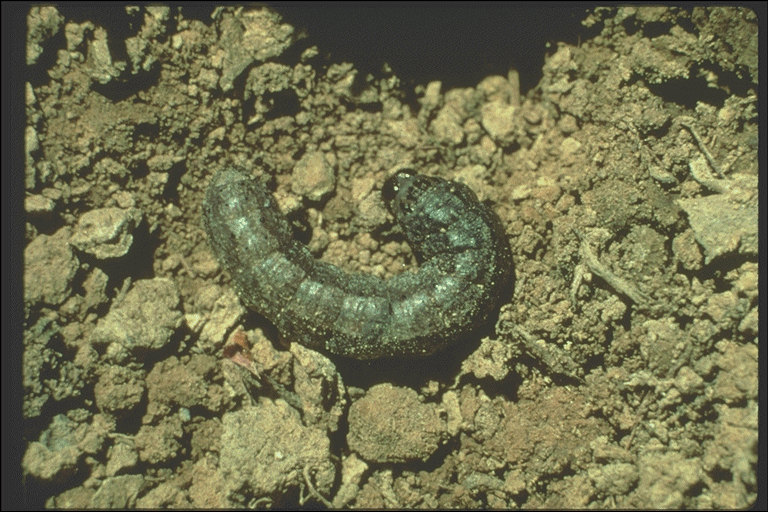
Cutworms are the larvae of moths. These night-flying moths are frequently attracted to lights at night. The 1-1/2 to 2-inch moths are dull-gray to brown with yellow, gray, light brown, and black designs on the front wings. The hind wings are usually solid in color and lighter than the front wings. Moths lay eggs singly or in clusters on the leaves of grasses, weeds, other host plants, and sometimes on the bare ground.
Cutworms are smooth-skinned and somewhat shiny. They range in color from gray to dark brown with distinctive stripes and spots. When fully grown, cutworms can reach 1-3/4 inches in length. Cutworms commonly coil up in a "c" shape when disturbed.
Cutworms feed mostly at night and hide during the day under clods of soil or in burrows below the soil surface. They cut off the stalks of young plants at or just below the soil surface and feed on the buds or leaves. They rarely consume the entire plant, but more commonly move to the next plant in the row or to another row. Infestations typically are not uniform within a field, so the loss of a plant stand tends to occur only in parts of a field.
Late planting, moderate to heavy infestations of broadleaf weeds prior to planting, poor field drainage, or an abundance of crop residue, especially soybean straw, are factors that contribute to cutworm problems. Fields with combinations of these characteristics or a history of cutworm problems have an increased potential for damage. Preplant or planting time applications of soil insecticides or broadcast sprays may reduce cutworm damage but are generally not an economical strategy. Fields receiving a preventive cutworm treatment should be watched; economic damage may occur where cutworm pressure is great. Rescue treatments can be applied when field inspection indicates that an economic infestation is present. This is the most cost efficient strategy to follow. Frequent field scouting and early detection of the problem is essential. Treat when 30 % of young plants are cut and live larvae are present.
| Insecticide | Rate per Acre | Days to Harvest/Forage |
|---|---|---|
Ambush 2E (permethrin) |
6.4 fl oz |
60 (Grain) Do not harvest for forage or hay |
Asana XL (esfenvalerate) |
5.8 to 9.6 fl oz |
21 (Grain) Do not feed or graze livestock |
Baythroid 2 (cyfluthrin) |
0.8 to 1.6 fl oz |
45 (Grain & feeding dry vines) 15 (Green forage) |
Fury (zeta-cypermethrin) |
1.4 to 4.3 fl oz |
21(Grain) Do not feed or graze livestock |
Bacillus thuringensis "B.t." |
Caterpillars can be controlled by many products containing the active ingredient Bacillus thuringensis or "B.t." Biobit, Deliver, Dipel, Javelin and Lepinox are examples of these products. Check the label for rates. | |
Larvin 3.2 AF (thiodicarb) |
20 to 30 fl oz |
28 (Grain) Do not feed forage, hay, or straw |
Lorsban 4 E (chlorpyrifos) |
1 to 2 pts |
28 (Grain) Do not feed or graze livestock |
Mustang Max (zeta-cypermethrin) |
1.28 to 4.0 fl oz |
21 (Grain) Do not feed or graze livestock |
Pounce 3.2 EC (permethrin) |
2 to 4 fl oz |
60 (Grain) Do not feed or graze livestock |
For more information see: Cutworms in Kentucky Soybeans, Entfact-132, http://www.uky.edu/Agriculture/Entomology/entfacts/pdfs/entfa132.pdf